Spotlight Interview: Banner Cardiovascular Center – West Valley
When Were Electrophysiology (EP) Services Started at Your Institution, and by Whom?
Banner Cardiovascular Center – West Valley (BCC-WV) is an outpatient cardiac catheterization and EP laboratory that opened in June 2021. The center was built from a joint venture between Banner Health, Atlas Healthcare Partners, and Cardiac Solutions. What set BCC-WV up for success was having one physician group (made up of 16 physicians) feed into the center. The Cardiovascular Center started with performing a handful of loop recorders per month and quickly increased to a more diverse procedure list, including left heart catheterizations, percutaneous coronary interventions, EP devices, peripheral angiography, and right heart ablations. On average, we have performed 180 cases per month in 2024. BCC-WV is a Joint Commission-accredited ambulatory surgery center.
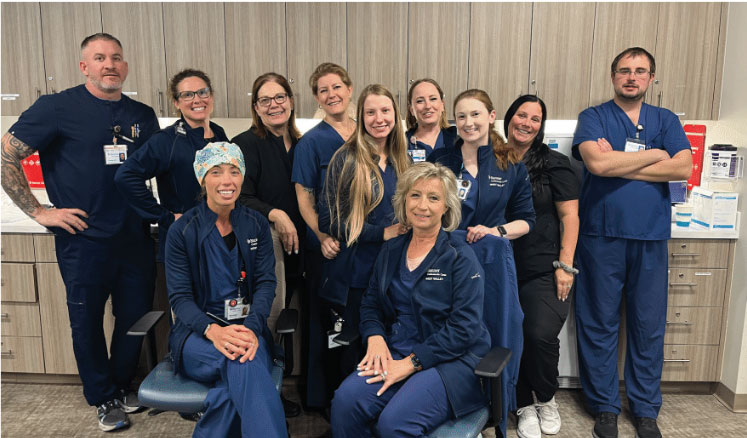
The BCC-WV team.
Who Manages Your EP Laboratory, and What Is the Mix of Credentials and Experience?
The current Chief Executive Officer is Charles (Chuck) Santos, RT(R). Chuck holds advanced cardiovascular certifications (ARRT, RCIS) and more than 30 years’ experience in the cardiac catheterization laboratory. Kimberly Wendt, RN, MSN, is the Director of Nursing. She has been a nurse for over 10 years, with experience in neurocritical care and cardiovascular/EP services as well as a master’s degree in nursing education. Tanya Stowe, RT(R), is the lead radiology technologist, performing her daily job duties along with managing inventory.
BCC-WV currently employs 21 team members. There are 8 registered nurses as core staff members, plus 5 additional registry nurses. There are 3 core staff radiology technologists plus an additional registry radiology technologist. In addition, the center utilizes a medical assistant and scheduler. All staff members have come from a cardiac catheterization and/or EP laboratory in a hospital setting. Staffing needs remain unique in an ASC setting, where maximizing the staff’s scope of practice is essential. BCC-WV encourages nurses to scrub into cases where fluoroscopy is not needed and have our radiology technologists help in the pre/post-operative setting.
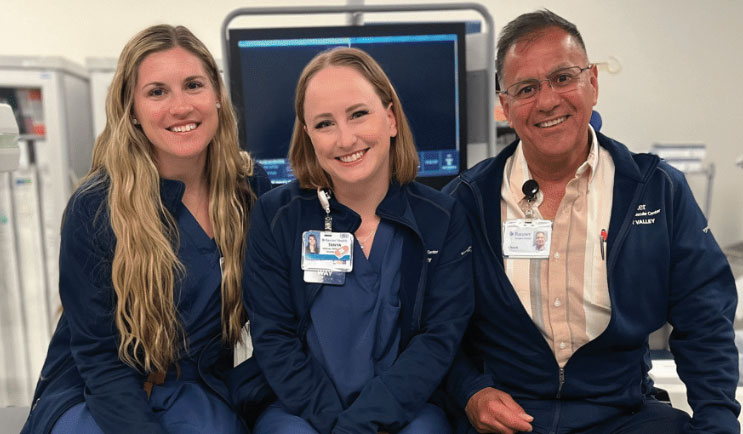
BCC-WV leaders Kim Wendt, RN, MSN; Tanya Stowe, Lead RT(R); and Chuck Santos, CEO.
BCC-WV currently employs 21 team members. There are 8 registered nurses as core staff members, plus 5 additional registry nurses. There are 3 core staff radiology technologists plus an additional registry radiology technologist. In addition, the center utilizes a medical assistant and scheduler. All staff members have come from a cardiac catheterization and/or EP laboratory in a hospital setting. Staffing needs remain unique in an ASC setting, where maximizing the staff’s scope of practice is essential. BCC-WV encourages nurses to scrub into cases where fluoroscopy is not needed and have our radiology technologists help in the pre/post-operative setting.
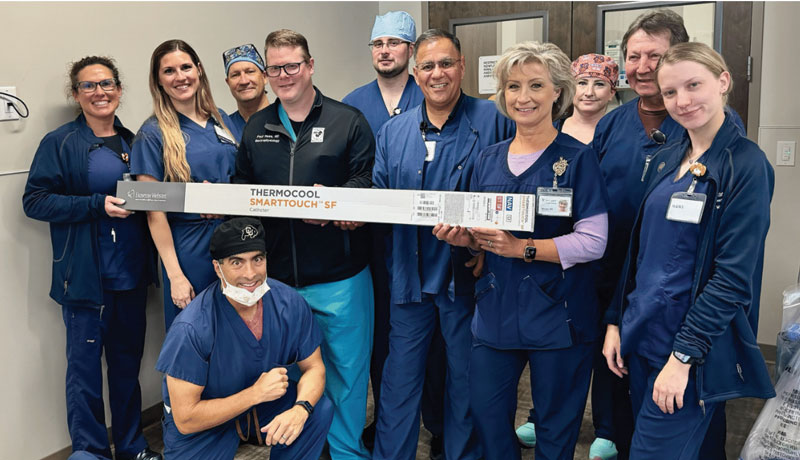
The first ablation was completed at BCC-WV by electrophysiologist Paul Haas, MD, FACC.
What Is the Size of the Facility?
Currently, BCC-WV has three 400-square-foot procedure laboratories, with 12 pre-/post-operative holding bays.
What Types of Procedures Are Performed at Your Center? Approximately How Many Are Performed?
On average, 10 biventricular device implants, 10 implantable cardioverter-defibrillator implants, 25 pacemaker implants, and 45 subcutaneous cardiac rhythm management (SCRM) implants are performed each month.
In April 2024, the center successfully implemented its ablation program, performing right heart ablations for supraventricular tachycardias and atrial flutters, as well as atrioventricular node ablations.
Tell Us What a Typical Day Is Like in Your Center.
A typical day consists of one room dedicated to left heart catheterizations/peripheral angiograms and another room dedicated to EP. On Tuesdays and Thursdays, we implant SCRM devices in the morning, performing between 6-8 loop implants/day. Additionally, a cardiovascular laboratory in the outpatient setting offers no weekend or holiday call, maximizing work-life balance.
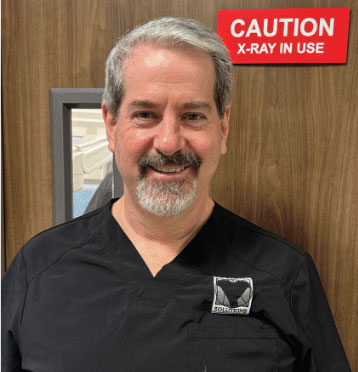
Mark Burns, MD, FACC, FRCP(C), electrophysiologist.
Mark Burns, MD, Facc, Frcp(C), Electrophysiologist.
BCC-WV is in Sun City, an age-restricted community for active retired adults. The population that BCC-WV serves is about 90% Medicare patients and 10% commercial. We are also affected by “snowbirds,” so we see an influx of patients from November to April. Although retired, our serviced population remains active and relies on word of mouth regarding health care.
Does Your Regional Area Have Specific Challenges?
A challenge that is presented in a retirement community is the continual increase of health care costs. The outpatient setting allows for a shift in non-complex, low-risk patients from the hospital. This not only lowers the cost for patients, but still allows for high-quality, personalized care.
Another challenge is the multitude of other outpatient cardiovascular centers opening in the West Valley of Phoenix. The competing centers may offer higher wages and more paid time off, which potentially can impact market analysis, but BCC-WV counters this with a great work environment and employee satisfaction.
The biggest challenge with our population is making sure they are correctly informed and can fill out the pre-admission process. A pre-admission testing nurse was brought on to specifically screen patients and help them through their questionnaire, so there are no surprises on the day of the procedure.
How Do You Ensure Timely Case Starts and Patient Turnover?
Quality metrics are measured with every case and include first case on-time start and patient turnover. These metrics are reviewed monthly and reported quarterly at the Governing Board meeting. BCC-WV ensures timely case starts by consistent communication to the physicians. Current patient turnover is at 10 minutes.
What Continuing Education Opportunities Are Provided to Staff Members?
Along with the assigned annual regulatory learning, BCC-WV offers monthly cardiovascular-focused education. When implementing the ablation program, we had dedicated educational sessions focused on anatomy/physiology, radiofrequency ablation, and mock procedures. The foundation of the ablation education was based on the textbook Understanding EP: A Comprehensive Guide by Paul Haas, MD.
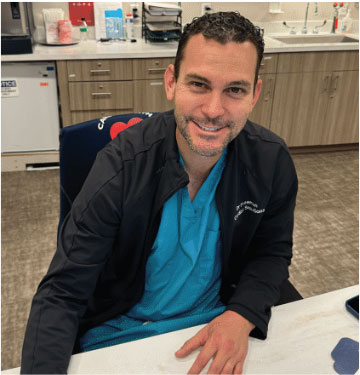
Wilbur Freeman, DO, MBA, FACC, electrophysiologist.
What Measures Has Your Laboratory Implemented to Cut or Contain Costs?
The largest cost saver for BCC-WV is utilizing just-in-time ordering, which minimizes product sitting on the shelf. By using this method, an accurate supply cost per month can be reported to the Governing Board and managing partner. BCC-WV also promotes the use of consignment and trunk stock. National agreements with vendors have also allowed for cost containment.
Please Tell Our Readers What You Consider Special About Your Center and Staff.
BCC-WV prides itself on a culture, built from the foundation up, that emphasizes open communication, daily staff huddles, and frequent debriefs. Our staff has a long-standing history with Cardiac Solutions, which has built a culture of trust in and out of the procedure rooms and helped BCC-WV physicians find the right staff. Atlas Healthcare Partners offers quarterly incentive payouts to staff based on patient and physician experience; they also receive annual service milestone awards. All these factors have contributed to minimal staff turnover and an incredibly positive work environment.
